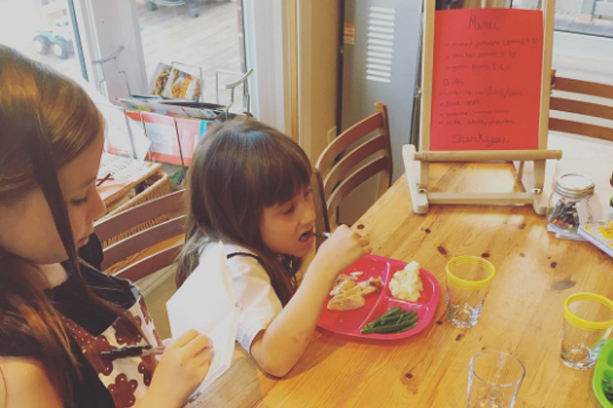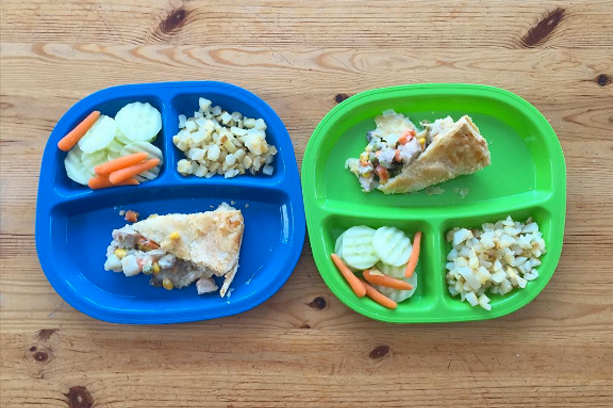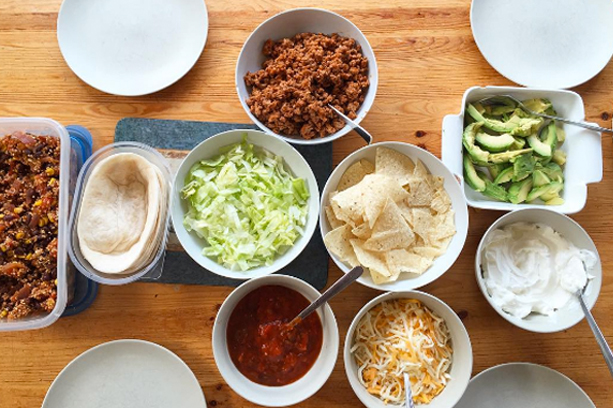How I Get My Kids To Sit Down and Actually Eat Dinner

When it comes to navigating family meals, my husband and I share the same goal. We want the dinner table to be a place everyone feels welcome and happy to spend time.
But as parents, we still have to do the work of instilling a healthy relationship with food. And it is work because kids will be kids. Mine certainly have their own ideas about what they’d like to eat every night. With four kids to feed, we knew we had to focus on keeping things positive.
Here are some of the strategies we use to keep our kids coming back for more:
Bring Them to the Store
I get it, you guys. I like to head to the grocery store alone while my husband stays home and puts all the kids to bed, too. But we also know how important it is for the kids to see the inside of a grocery store. So when it’s safe, and when we have a shorter list or a specific meal to shop for on the weekend, we bring the kids with us.
We want them to understand how a grocery store is laid out (good foods around the outside, treats, and non-perishables on the inside). We want them to go through the process of creating a menu plan and going in search of ingredients. We want them to see us pick up the fruits and vegetables and test them for freshness and ripeness. We want them to understand the value of using a list to minimize waste.
And most importantly, we really want them to feel the anticipation and excitement that comes from planning and creating a meal to serve to the rest of the family (and yes, the disappointment when your hard work isn’t appreciated).
Cook at Home
It’s not just grocery shopping that I like to do alone. I like to have the kitchen to myself, too. Unfortunately, that doesn’t do my kids any favours.
Cooking with your kids teaches them a lot beyond how to read a recipe or measure ingredients. It also helps them to understand why we flavour foods in certain ways or pair certain foods together. We have a collection of kids’ cookbooks and they are invited to spend time in the kitchen on the weekends trying out new ideas. We’ve also taught them some of their grandparents’ recipes, which we keep in a family cookbook.
On Sunday evenings, we turn the dining area into a restaurant as often as we can. The kids make up menus, set the table extra fancy, and throw on aprons for serving the meal. This has become a much-loved family tradition, and it’s a great way to remind kids that dinnertime is about family time.

Divide and Conquer
I started using divided dishes when my babies were young and first eating solid foods because they allowed me to individually introduce flavours and textures to my new eaters. But over the years, we realized divided dishes also allowed our no-sauce-touching-my-pasta and our must-see-what-I-put-in-my-mouth-before-I-eat-it kids to have some control over how they ate their food.

An added benefit was manageable portion sizes. We don’t feed my kids adult-sized portions, and we don’t serve their food on adult-sized plates. Even though it means they may be hungry again later, we’re glad they get to experience those cues and learn what to do about them (like grab a healthy snack before bed).
We also let them independently increase their portion size during dinner by providing the first serving on their plates (a taste of everything) and then placing the rest on a nearby counter or in the centre of the table with serving spoons. That way the kids are able (and welcome) to add more to their plates and can make choices that suit their individual taste buds and appetite.
Try, Try Again
Any parent who has read anything about feeding kids knows it takes a lot of attempts for some foods to stick (experts say up to 15 times). Just the thought of watching a serving of veggies get rejected that many times is exhausting, but we have to do it anyway. Watch out for the ‘my kid doesn’t like that food’ mindset which leads to avoiding it altogether. If there’s one thing I’ve learned from feeding a large family, it’s that there will always be someone at the table who doesn’t like something we’re eating. We won’t put that food item in their school lunch boxes, but we will keep serving it at dinnertime—with a reminder about the people in the family who do enjoy it.
We repeatedly cook asparagus, because it’s a favourite for my husband and me. We put one stalk of it on each kids’ plate and they’re encouraged to try it each time. Two of the kids have managed an entire stalk and the other two have conquered an inch. We do a lot of cheering each time. There’s no pressure, but there’s no avoidance either.

Sit Down and Eat
I’m looking at you, parents. This rule is so important when it comes to the true value of the family dinner: spending undistracted time together. An important aspect of joining your kids at the table is to role model your own enjoyment of food.
Don’t talk about calories or portion sizes or what you should and shouldn’t eat. Do talk about what you like about the flavours and textures and traditions of the dishes (like a favourite meal from your own childhood).
Many of my greatest childhood memories happened around the kitchen table in my parents’ home, and it was something I missed a lot when I moved out. My husband has many wonderful memories of weekly dinners with his grandparents. We want our children to miss dinnertime with us, too.
Invite Others to the Table
A few weeks ago, we decided to expose the kids to a smorgasbord of Indian food. We set out all the food family-style and they are allowed to serve themselves as much or as little as they want of each food.
If any of our kids had decided to load up her plate up with nothing more than naan bread, we wouldn’t have batted an eye. But my kids watched each other’s choices and reached for things they hadn’t tried before. The meal was about spending time with family and because there wasn’t any pressure to try new foods, they were actually more apt to try them.
The same goes for when we can have gatherings with extended family. We used to all pitch in and bring different food dishes to the meal. We would tell the kids they can take what they want, go back for seconds of the food they like, and not to worry about the stuff they don’t. They aren’t allowed to make comments or negative remarks (and this requires teaching for sure).
With each passing year, they’ve expanded their choices and tried things we’ve never had before. We also try to introduce something new when it comes to what our family contributes to the shared table.
I’ve always said I ended up with a big family because I had a vision of a long dining room table lined with my grown kids and their partners and their kids. We believe in feeding our family well, but we also believe in making our dinner table a safe place to be together.
If our grown kids come back to our door someday carrying a dish with something new they want to share with us, we’ll know we got it right.














